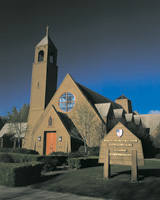6x9 View/Field Cameras
Little Cameras, Big Results
Many years ago, still fresh
out of college, I worked with a 21/4x31/4" Century Graphic. I
bought it used with three lenses and it was so cool. Pebble-grained
gray leather covering, bright red bellows, and a coupled rangefinder.
Wow, I naively thought, it would do anything. Weddings, portraits, scenics,
products, you name it. Anything a client wanted got shot with that spiffy
little Graphic. |
|||
One thing that has changed
is that I am now a multi-format photographer, which is definitely a mixed
blessing. When my wife and I travel the country in our converted van I
love to shoot the historic missions, bridges, rustic barns, Victorian
homes, and lighthouses we find along the way. My favorite camera for these
subjects, as well as the grand landscape, is a 4x5 view camera. However,
as Ann and I approach retirement age, and prepare to do a lot more traveling,
I'm starting to be concerned about the volume of camera gear I carry.
So, I have been thinking about ways to shave some of the weight, and bulk,
off the view camera outfit without simply leaving it behind. |
|||
Size And Weight Considerations Check The Movements |
|||
Tilt is a tilting, around a
horizontal axis, of the front or rear standard of the camera. Swing is
like a tilt but the standard rotates around a vertical axis. Applied to
the camera's front standard, tilt or swing affects the plane of
focus. It is often stated, wrongly so, that this increases depth of field.
It doesn't. It merely changes the plane of focus so that it more
closely matches the plane of the subject. Applied to the camera's
rear standard, tilt or swing will affect the shape of the subject or perspective.
A complete tutor on the use of camera movements is beyond the scope of
this article--check the sidebar for some books on this subject if
you need to review. While front swings and tilts are important, they are
less so for the camera back. In fact, my Gowland's rear standard
had only tilts and I never really missed the other movements at all. |
|||
Rise and fall is pretty much self-explanatory. You raise or lower the standard, which in turn moves the image on the ground glass. Again, many field cameras dispense with rise/fall on the camera's rear standard, as front rise/fall is more likely to be employed. Lateral shift, or slide, is rare on field cameras, as the same thing can be accomplished, albeit less conveniently, by moving the tripod. I wouldn't take a camera off my short list solely because it didn't have shift, but it can be a convenient feature. Bellows Exchange |
|||
Telephoto lenses can be used
as a work-around for cameras with a short bellows, but they tend to be
pricey. Another nice feature is a standard size lensboard. Many cameras
use proprietary lensboards, so if you want to use the lenses between two
cameras you'll need to remount the lenses every time you switch
cameras. With a more common lensboard, such as the Linhof Technika, the
boards are often interchangeable between camera brands or there may be
adapters to allow compatibility. |
|||
Oh yeah, don't forget, there is no universal camera...trust me! Suggested Reading Kodak Book of Large Format Photography; Roger Vail; Silver Pixel Press, 21 Jet View Dr., Rochester, NY 14624; ISBN 0-87985-771-4; soft cover; 112 pages; $19.95. Large Format Nature Photography; Jack Dykinga; Amphoto Books, 770 Broadway, New York, NY 10003; ISBN 0-8174-4157-3; soft cover; 144 pages; $29.95. Photographing the Landscape; John Fielder; Westcliffe Publishers, Inc., PO Box 1261, Englewood, CO 80150; ISBN 1-56579-150-9; hard cover; 191 pages; $50. |
|||
View Camera Technique, 7th Edition; Leslie Stroebel; Focal Press, 200 Wheeler Rd., 6th Floor, Burlington, MA 01803; ISBN 0-240-80345-0; hard cover; 376 pages; $64.95. Manufacturers/Distributors Badger Graphic Sales, Inc.
(Ebony cameras) |
|||
Gowland Productions HP Marketing Corp. (Linhof
cameras) Schneider Optics, Inc. (Horseman
USA) |










































